Naturally, this horrifically painful and life-threatening disaster just made Monty want to go back to Ghana as soon as possible. He and Kurt were planning to return in August with a small number of other herpers to give Ghana a trial run as a potential guided herp-trip destination. Monty asked me if I wanted to be in that small group, and I jumped at the chance. I figured Monty would know how to avoid the wasps this time, and Kurt would spot any venomous snakes before they could bite us, so we should be completely safe.
In the end the small group of herpers solidified into just two: me and Paul Norberg. So there were four of us, plus a local guide named Baturi whose day job was snake catcher in the capital city of Accra. For such a distant location it was a short trip; I flew in on August 8 and flew out on August 16. In that time, we spent three nights in one forest location, two nights in another, and the other three in Accra. Most of the time in Accra was simply required by travel schedules, though we did spend a day and a half in some half-wild savanna lands east of the city.
Our first destination, a few hours inland from the coastal city of Accra, consisted of a lodge, a few acres of cultivated land in which a variety of butterfly-attracting plants were maintained, and the surrounding forest containing a few foot trails. A wide dirt road led to the lodge and continued indefinitely through the forest. We looked for animals by wandering around the grounds, hiking on the foot trails, and walking along the dirt road edges.
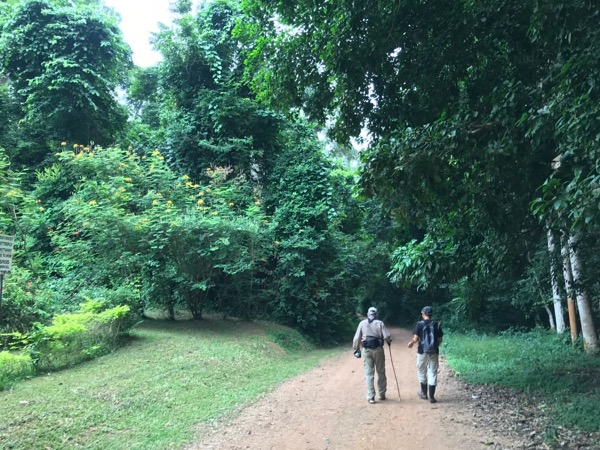
As always in tropical forests (and really pretty much anywhere), insects and other invertebrates were much more plentiful and visible than herps. I like a big, colorful, or weird-looking invertebrate as much as the next sensible person, so I will inflict some photos of them upon you.
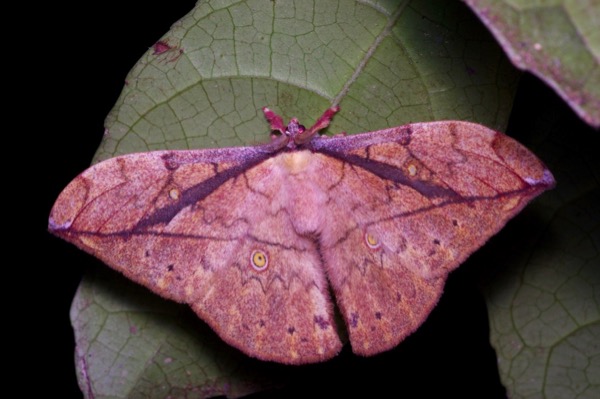
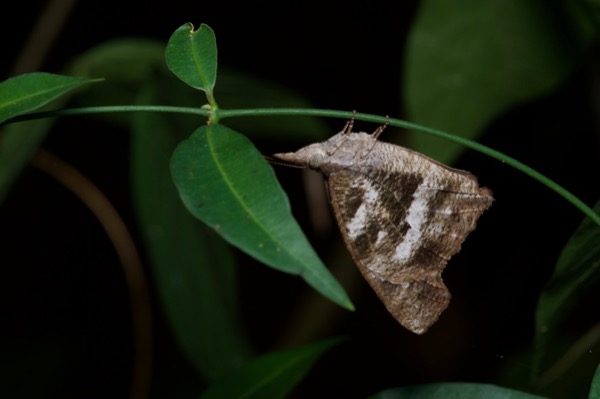
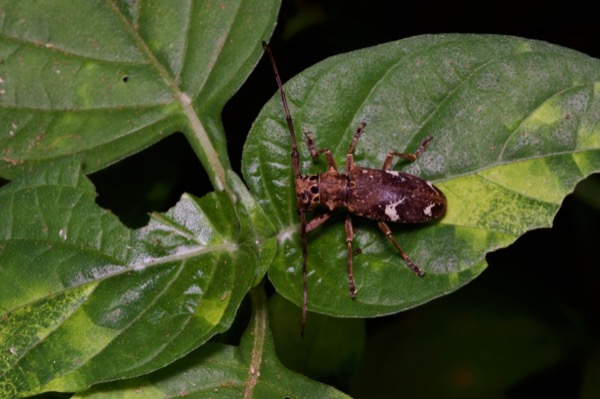
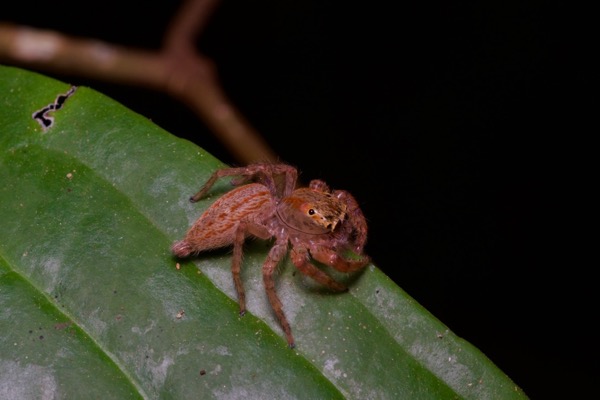

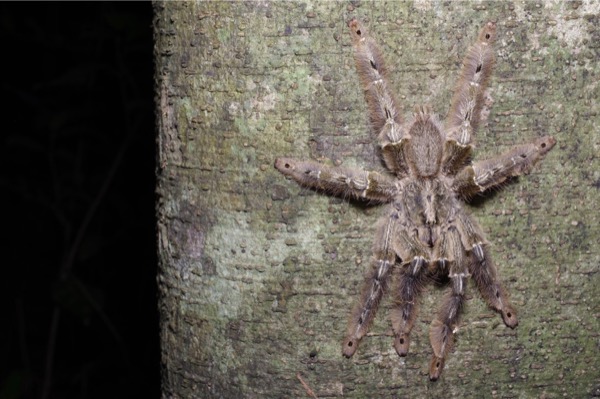
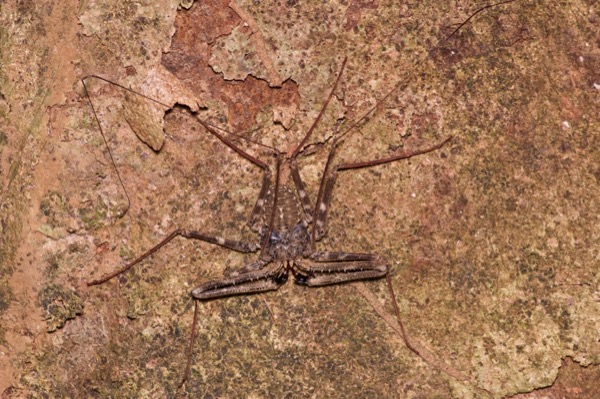
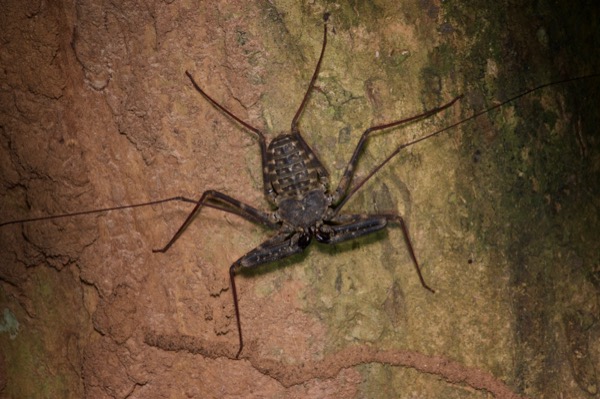
Now comes the parade of katydids, roughly ordered from least to most interesting-looking. I have no more specific identifications except for the very most interesting one.
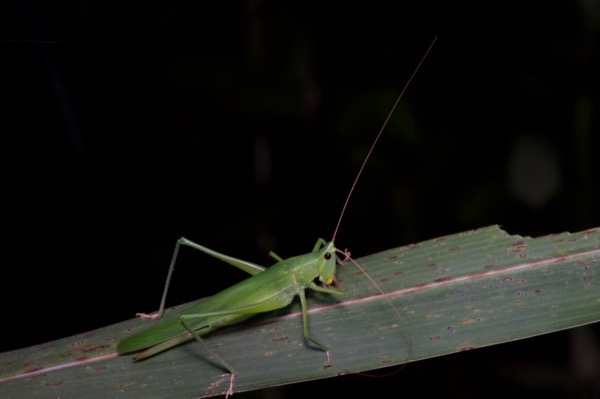
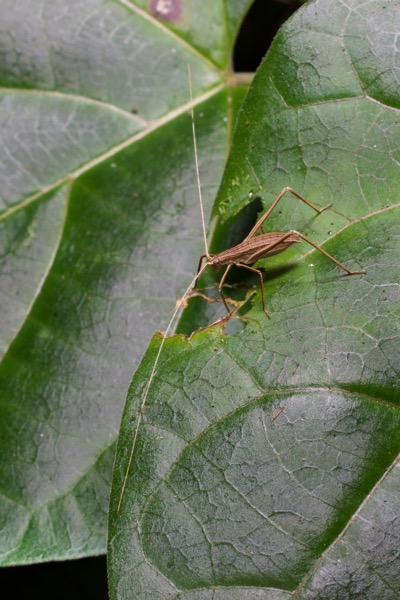
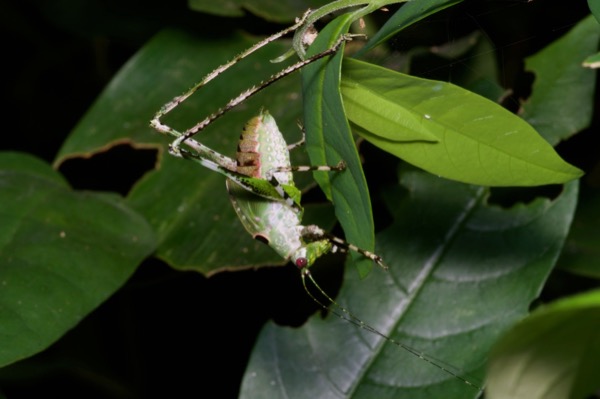

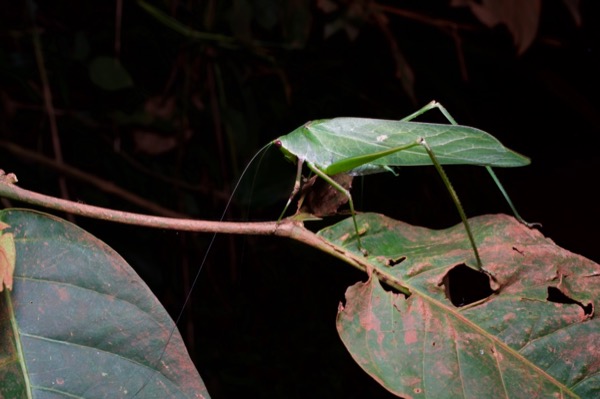


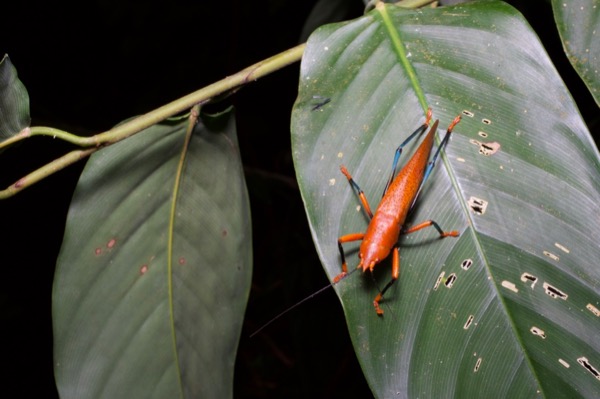
As everyone knows, among the best insects are phasmids (stick insects) and mantises. In my recent trips to Malaysia I saw dozens and dozens of stick insects, but only a tiny handful of mantises. In Ghana I saw dozens of mantises, and no stick insects at all. Thanks to African mantis expert Nicholas Moulin for identifying my photos to the extent that the photos would allow.
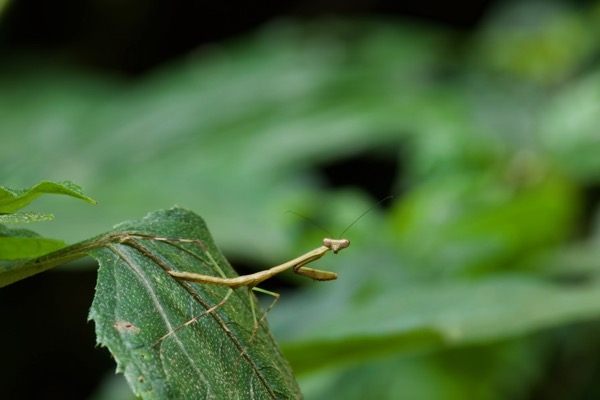


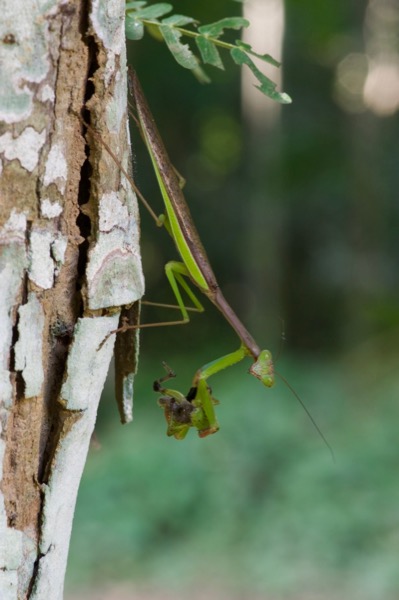
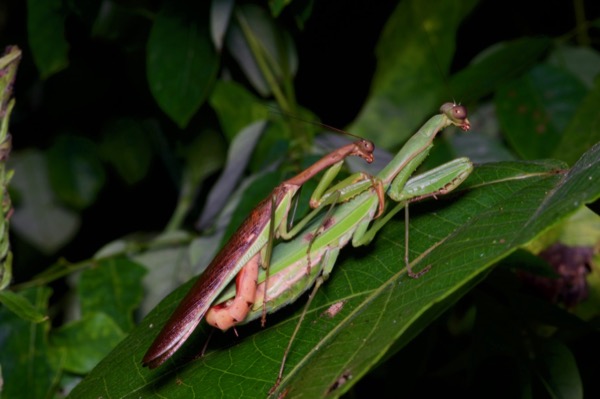
And the best mantis I've personally ever found (drum roll please)...
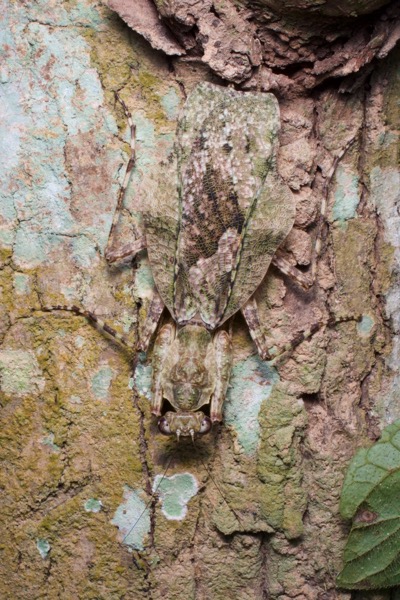
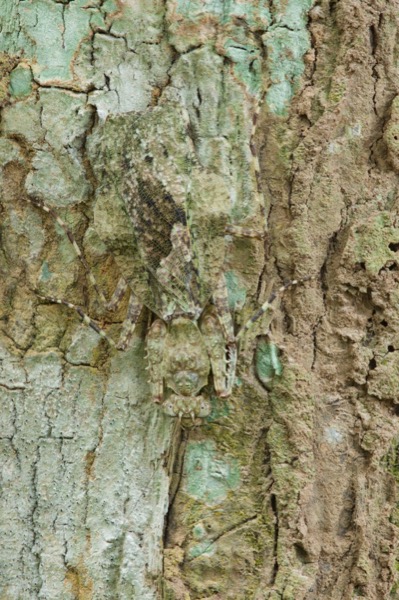
Marvelous as that mantis was, you are probably wondering by now whether we found any herps at this location. We did, though not in impressively large numbers.
Your basic small brownish frogs sat on low vegetation at night and occasionally on the muddy ground or in leaf litter by day. These belong to genus Arthroleptis, aka Squeaking Frogs or just Squeakers. We had the good fortune of meeting up with Ghana frog expert Caleb Ofori Boateng, who told me that the systematics of Arthroleptis is all messed up right now, and any existing keys to distinguishing species are not to be believed. So all I know is that we saw a bunch of Arthroleptis, which might be a single species or several species.
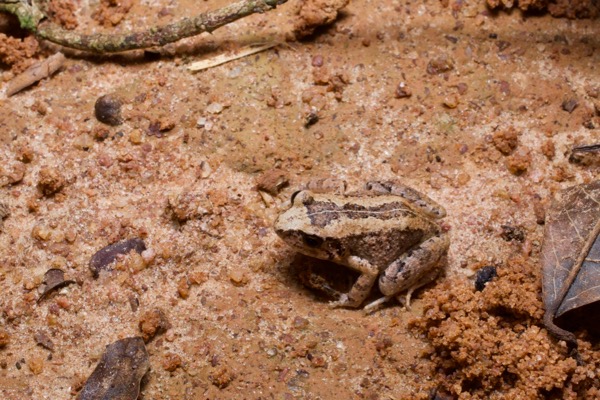

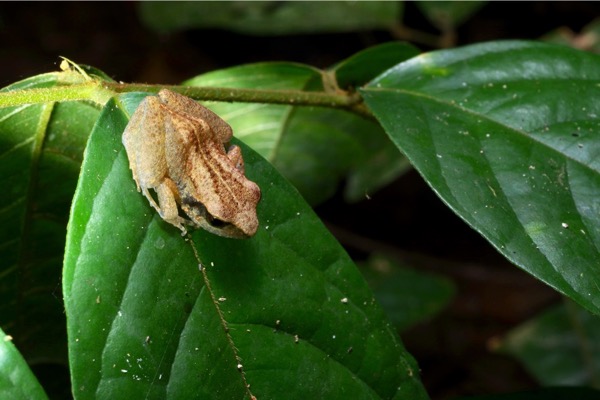
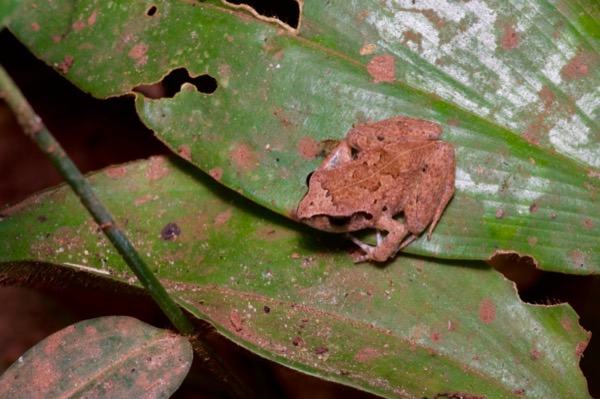

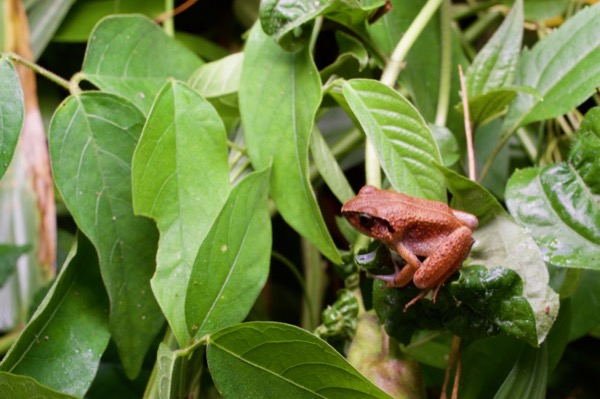
One afternoon I spent at least ten minutes chasing around possibly the smallest frog I've ever seen. I'm reasonably certain that this is an Arthroleptis metamorph, based on the (very thin) vertebral line and (very low-contrast) symmetrical pattern around it, as well as the stripey legs and general shape. It would hold perfectly still until I had my camera set up just right, then leap like Superman to a position a few inches away, where it would be nearly impossible to see due to its tiny size and good color match for the moist ground.
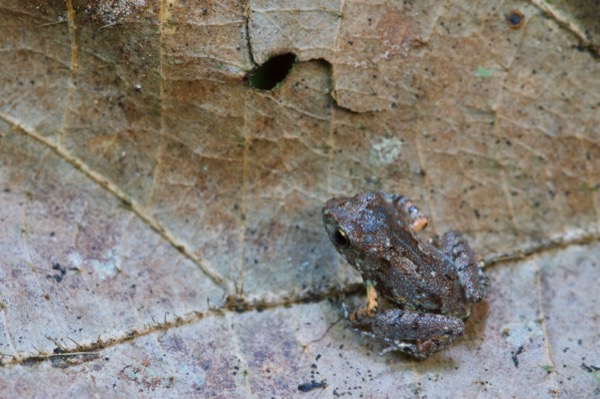
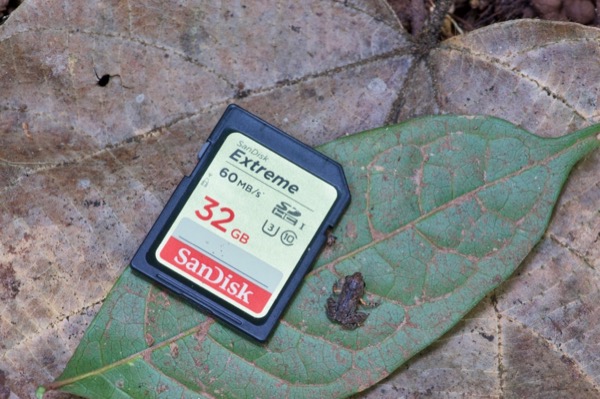
A small percentage of the small brownish frogs on the forest floor were Phrynobatrachus rather than Arthroleptis. Not just a different genus but a different family: Phrynobatrachidae rather than Arthroleptidae (someone wasn't feeling very creative when inventing family names from the pre-existing genus names). Unfortunately I failed to get Caleb to tell me which species this one was likely to be, and I haven't dug up enough information to distinguish the candidates clearly.
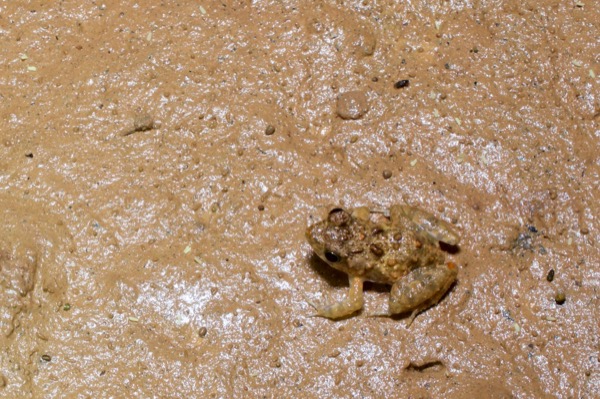
At the lodge, we ate our meals on a second-floor deck overlooking a sort of open natural courtyard between buildings. At night a light illuminated this area. A nearly universal rule: lights attract bugs; bugs attract toads.
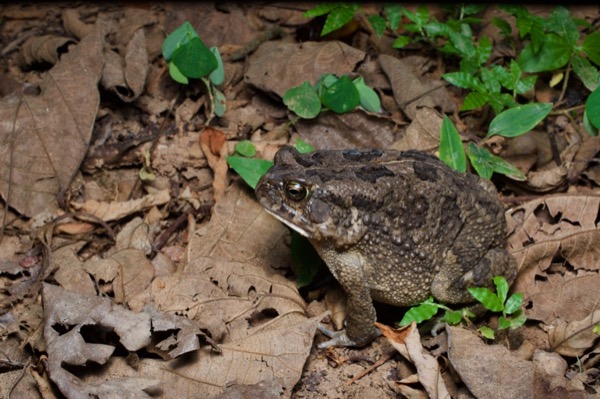
The largest frog in the area also has the distinction of being the species most commonly consumed by people. We saw a few of these in or near puddles in the dirt road at night.

Large, jumpy Grassland Frogs (Ptychadena sp) also called the dirt road puddles home. Some of these, with relatively smooth and solid-colored backs, were clearly P. longirostris. Others, with more ridged and patterned backs, might have been P. oxyrhynchus. These species are known to cohabit the same dirt-road puddles.

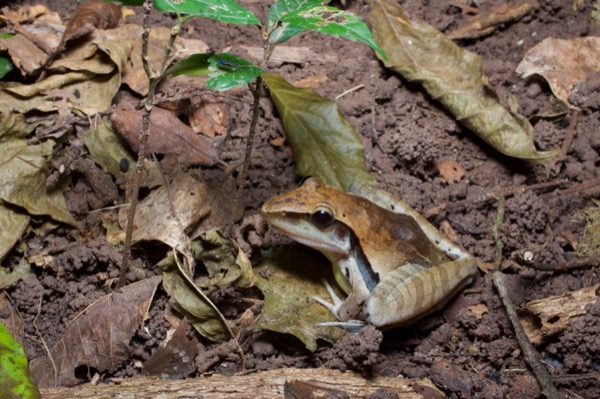

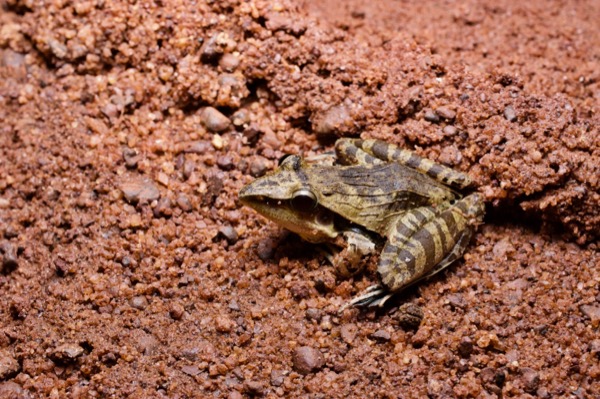
At this first forest location we found only two arboreal frogs, within five minutes of each other.
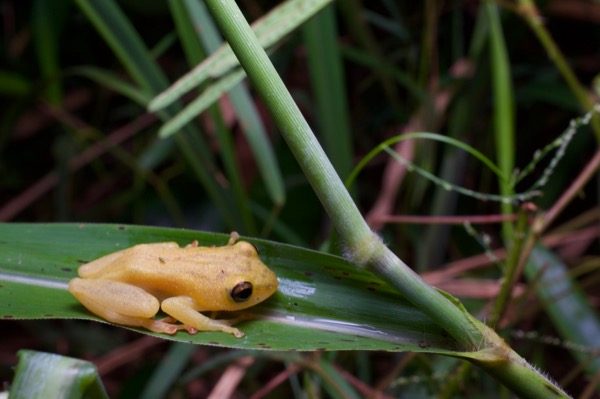
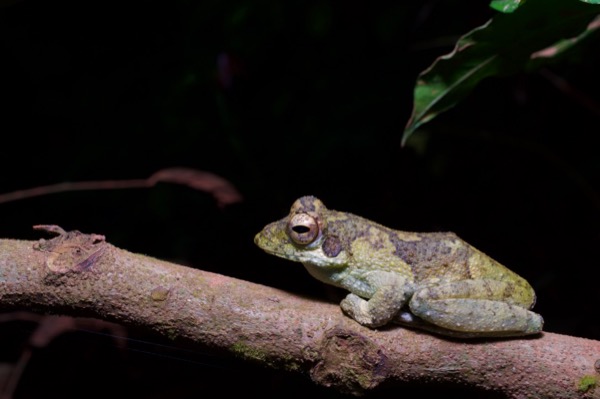
The lizards we found in this location ranged in size from tiny all the way up to small. Within minutes of arrival at the lodge area I spotted a colony of tiny but excellent ones near the base of a large tree. These are the only members of family Lacertidae in Ghana, the delightful Saw-tailed Lizards, sometimes known in the pet trade as Neon Blue Tailed Lizards. These little guys are fidgety, quick to dash off and squeeze their flattened bodies under flaps of bark. They are known for a form of primitive gliding. They wouldn't let me get anywhere near, but I managed a few photos from a distance with a tripod and 300mm lens. Given how soon after arrival I saw these, I assumed we would be seeing lots of them during our stay, but I guess I just lucked out with the weather conditions; I looked for them a few more times but only got one additional half-second glance as one scampered away.
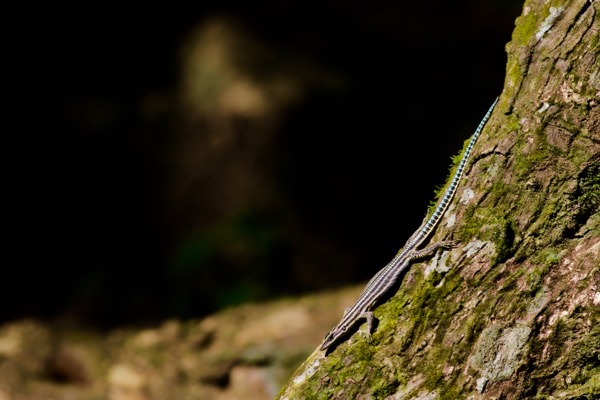
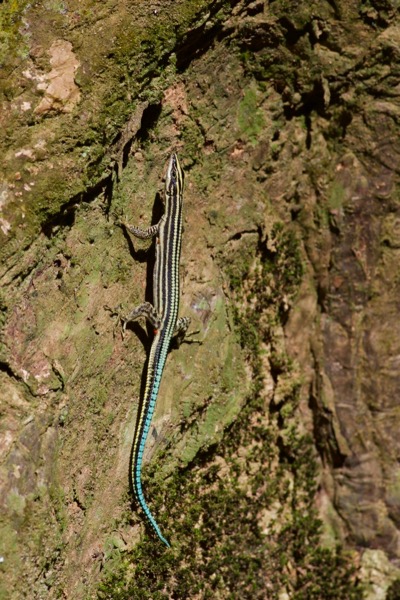
Most of the lizards we encountered were small brown skinks. Even with generous help from the expert Dr. Adam Leaché, some of them could only be identified to the genus level.
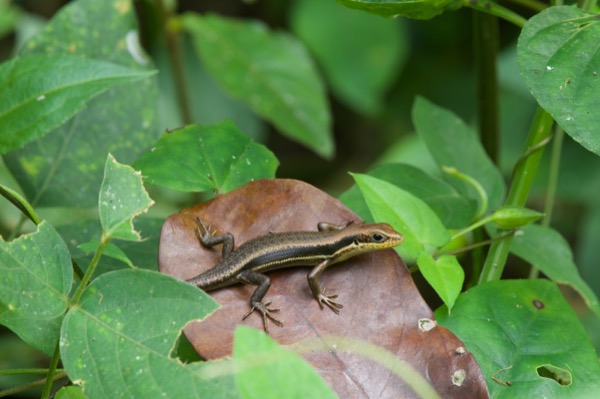

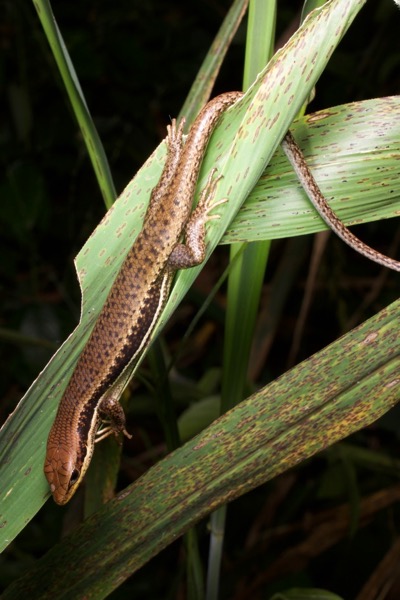
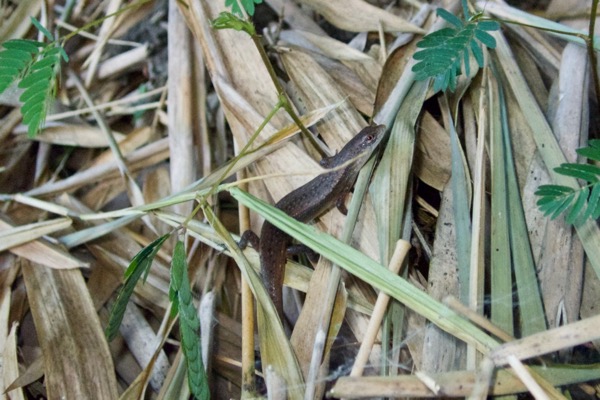
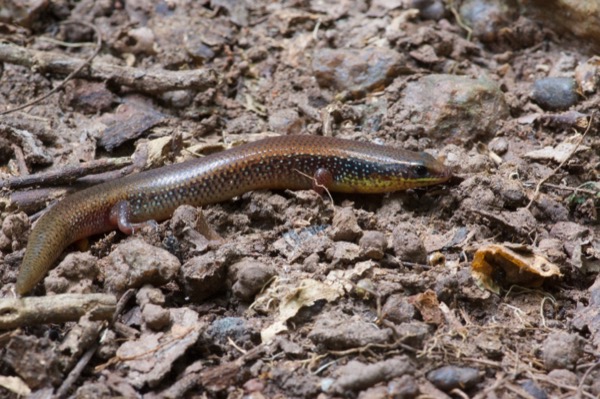
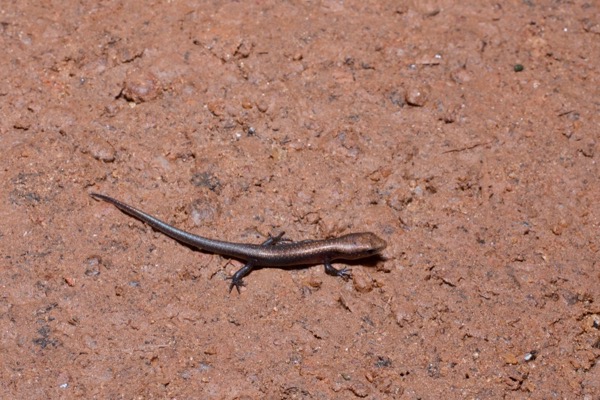
One afternoon Kurt spotted a small and beautifully rainbow-colored lizard on a tree trunk near the lodge. We recognized it as a Cameroon Dwarf Gecko. Males of this species sport crazy colors when they are feeling particularly manly. This one wouldn't stop moving, and Kurt caught him so we could pose him on some less easily escapable surface. The gecko had the last laugh, replacing his bright rainbow with very dark colors, nearly black. We let him climb around on a branch over which we had control for at least half an hour in hopes that he would return to his formerly beautiful appearance. He did not play along with our game, and we eventually gave up and returned him to his tree trunk.
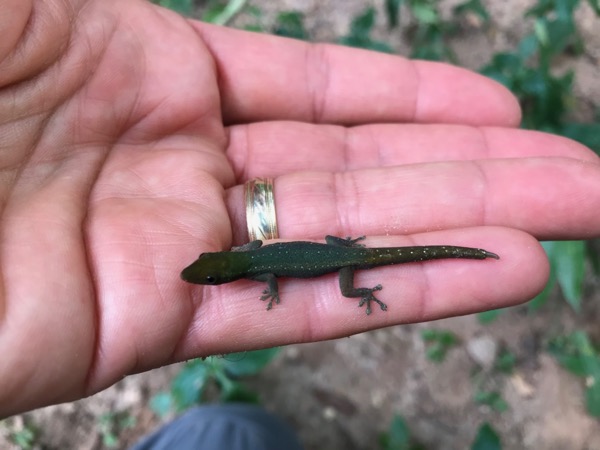
We kept an eye on that tree trunk for the rest of our stay, and though we did often see a pair of these geckos in non-stressed pale uniforms, the pretty colors were never resurrected.
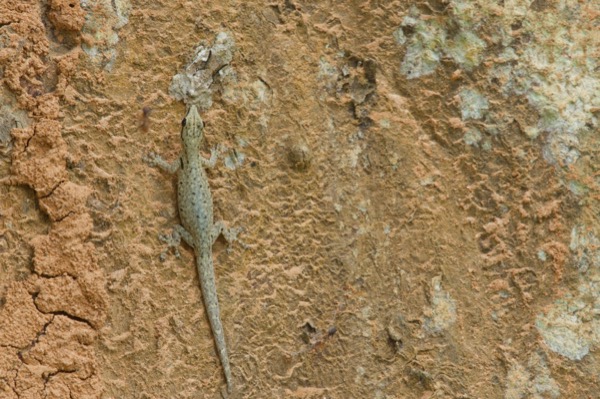
Most of the night shift geckos were Hemidactylus sp. that neither I nor Dr. Leaché could identify any more precisely. There are a number of similar-looking species in this area, whose distinguishing characteristics are not typically visible in photos.
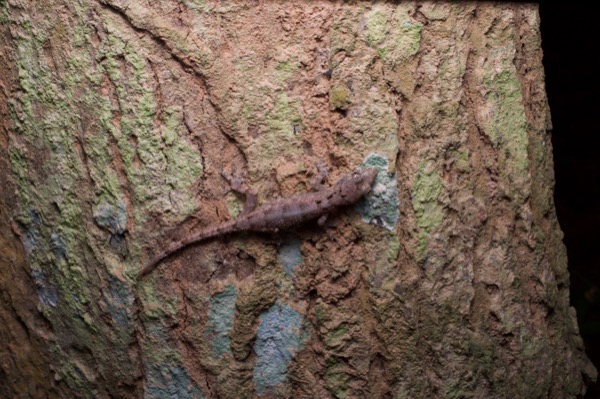
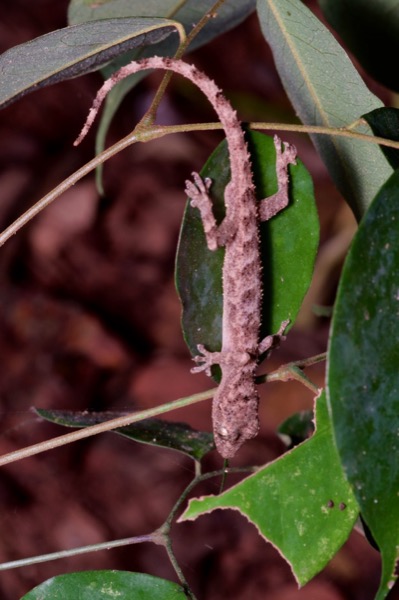
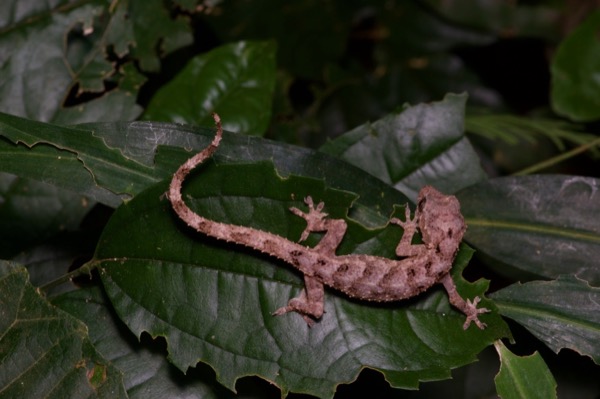
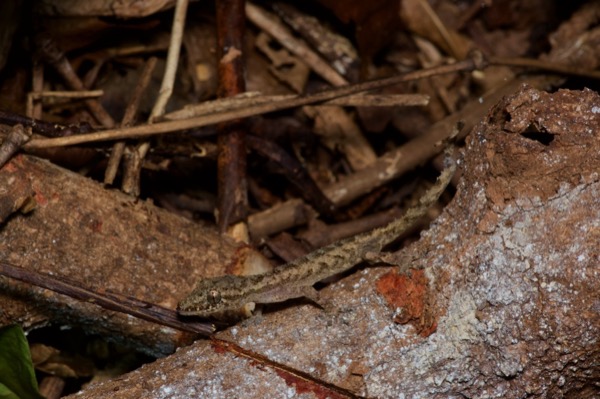
One good-looking Hemidactylus species was not at all difficult to identify. We saw one little baby and one adult.
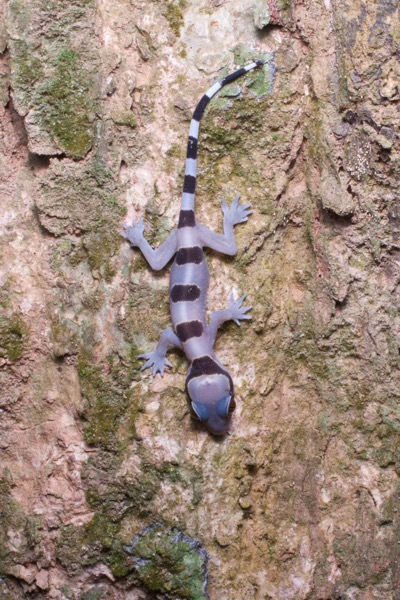
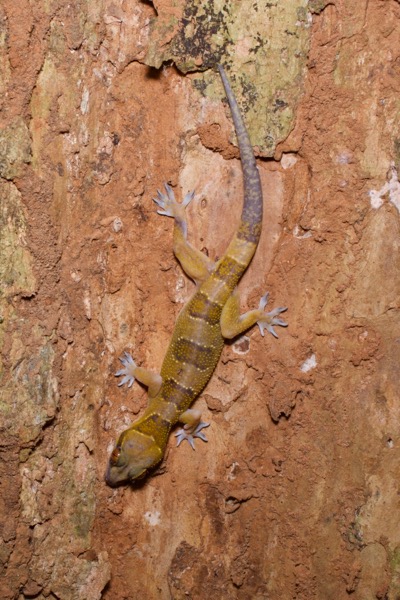
The last of the geckos we saw at this location was more or less the size and general shape of your typical small Hemidactylus, but didn't have the toe pads. It reminded me of the Cnemaspis rock geckos I had seen in Malaysia. Prior to the trip, Kurt had cobbled together an illustrated list of reptiles known from Ghana from a Wikipedia page (which, in turn, had gotten its data from The Reptile Database a few years earlier) and some Google image searching. This gecko was not on the list, but sure enough Dr. Leaché confirmed that it was a Cnemaspis, specifically C. spinicollis. The Reptile Database lists this species in some neighboring countries but not in Ghana, so it was fun to find one there. (No doubt Dr. Leaché was well aware that they were present in Ghana.)
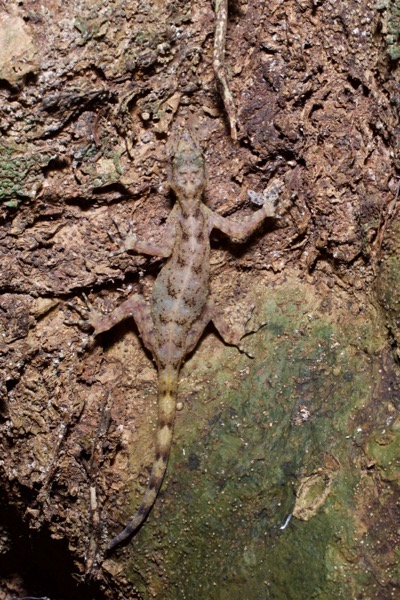
Snakes were hard to come by in the forest. On the first night, Paul started the snake count with this dark, somewhat iridescent, and quite head-shy dude. None of us were sure what it was when it was found, though we had some suspicion that it might be a Slender Burrowing Asp. We decided later, after Paul had let it crawl around in his hands for a while, that it was actually a harmless Western Forest Centipede-eater instead.

An hour or two later Kurt found the only other snake of the evening. After watching it squirm around on the dirt road for a while, he and I were trying to decide between weird worm, legless lizard, or blind snake. We did settle on blind snake, which turned out to be correct. We were so proud.
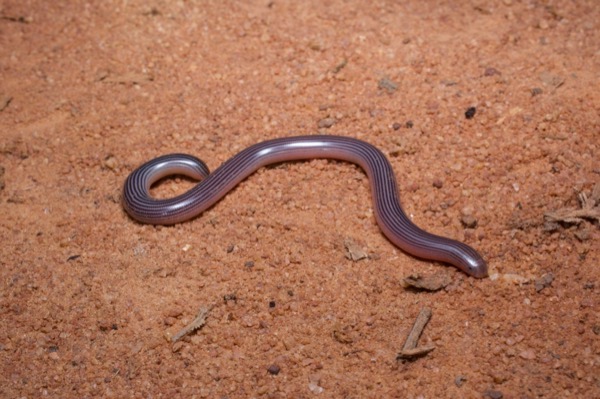
The next night Paul found a couple more snakes. The first one was the same head-shy species as from the previous night. It was caught and kept overnight for photos the next day.

The second snake Paul found was an extremely docile species climbing through a roadside bush. Again, we didn't know what species it was when it was found, but it seemed basically colubrid-ish. Probably not venomous! And it was so slow-moving and gentle. No trouble from this snake, as Paul grabbed it bare-handed and put it in a bag before it could climb away.
The next morning, when we released it from the bag for photos, it had adopted an entirely different personality. It flattened its head like a viper, striking repeatedly from a semi-coiled position. Paul, Kurt, and I were taking turns snapping photos and trying to identify it from the Kurt-compiled illustrated Ghana herps list I mentioned earlier. Now that it was angry and making viper-face at us, it was easy to recognize as a harmless White-lipped Herald Snake, since the photo of this species that Kurt had chosen for the herps list showed a similarly perturbed individual. After some time it gave up on trying to scare us and reverted to looking like an ordinary colubrid again.
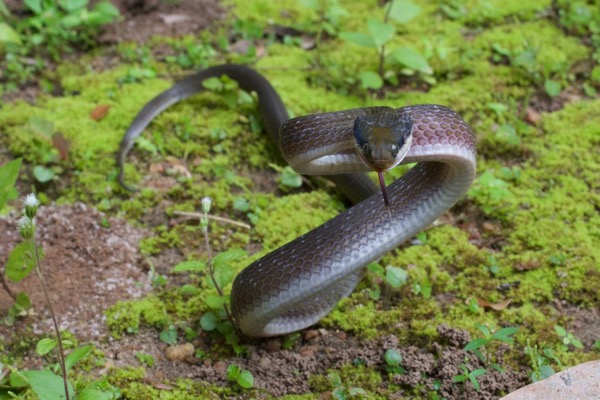
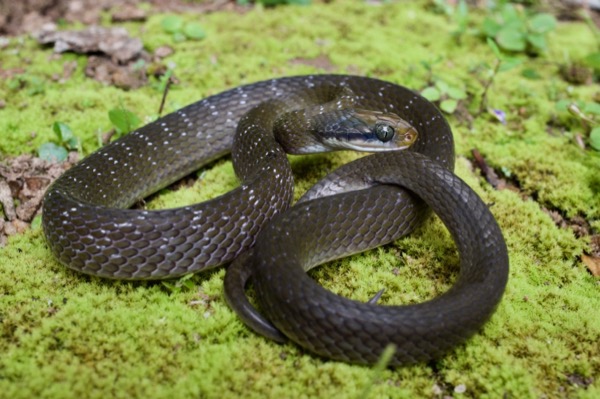
The third night was when Ghana frog expert Caleb Boateng Ofori came by the lodge with his wife and daughter. He was surprised we had seen so few snakes, because an earlier survey in this same forest had been quite successful with the snakes. But he realized that the earlier survey had been during the wet season, and we were visiting in the dry season, and that might have made all the difference. We saw no snakes on the third night. We did see a pangolin way high up at the top of a tree, but mostly just its tail.
Back on the first night hike, a noisy disturbance in the roadside vegetation turned out to be an adult Dwarf Crocodile. Not something we were really expecting, far from any known body of water. Monty performed a flying Steve Irwin impersonation and extracted our new friend to the dirt road for photos. This cute and probably cuddly crocodilian was between three and four feet long. After we had our fill of photos, we left the croc in a decent-sized puddle on the road.
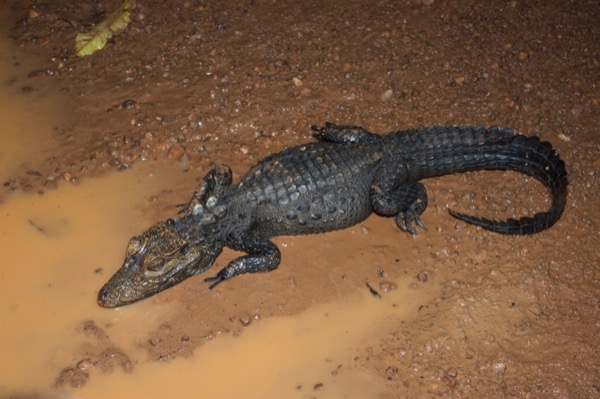
The next day Kurt and I were returning from a hike when we found Baturi and a local friend bringing another Dwarf Crocodile back into the forest; apparently they had caught it the previous night and kept it overnight. We took a few photos on a drier section of the dirt road and let them on their way. Looking at the photos now, I realize that this is the same individual as from the previous night (dried mud on the same scales, e.g.). So now I'm confused about when and why it was kept overnight. I sure hope it was actually released back into the forest.

Two or three hours of driving took us between the two forest locations we visited. In the middle we took a break at the Linda Dor Highway Rest Stop, consisting of a few small shops and restaurants. The grounds were patrolled by a squadron of large and wary agamid lizards. Agama systematics are in flux these days. Dr. Leaché ID'ed these as "Agama africana or Agama picticauda (some people call this Agama agama)".

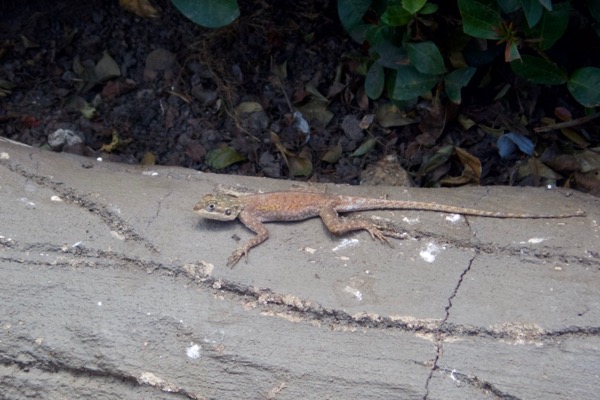
The second forest location had no lodge, nor road leading to it, nor cultivated area, nor amenities of any kind, other than those lugged uphill on a narrow path for an hour or so by us and a couple of extra people Monty had hired for this purpose.
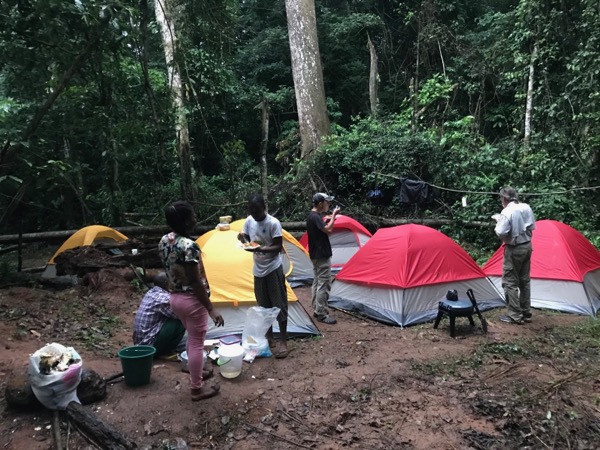
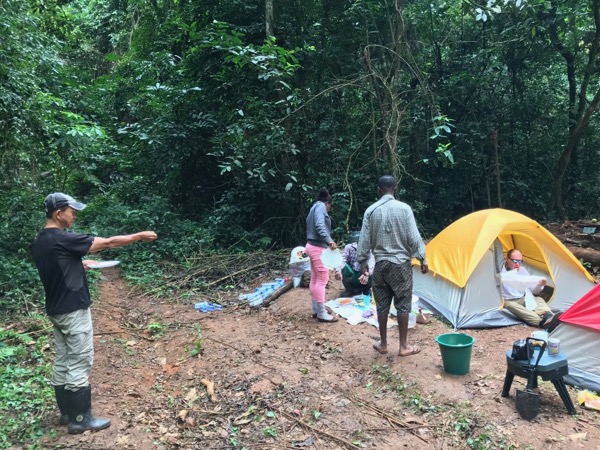
This is what Monty looked like after climbing up into the stilt roots of a swamp-dwelling tree. Note the sort of reverse pants-wetting look, sure to soon be popular among the more fashionable designers.
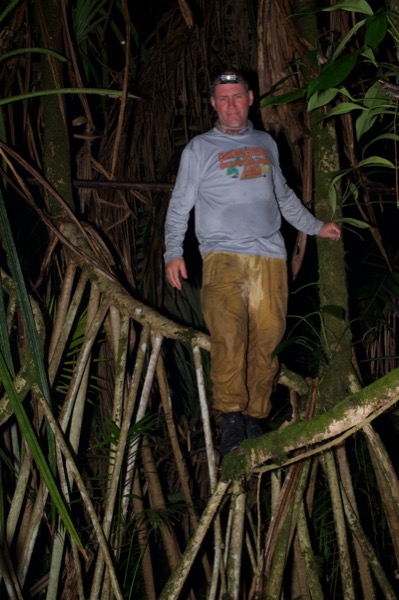
There were lots of good bugs in this forest also, and for the most part different ones. Here are a few of my favorites.
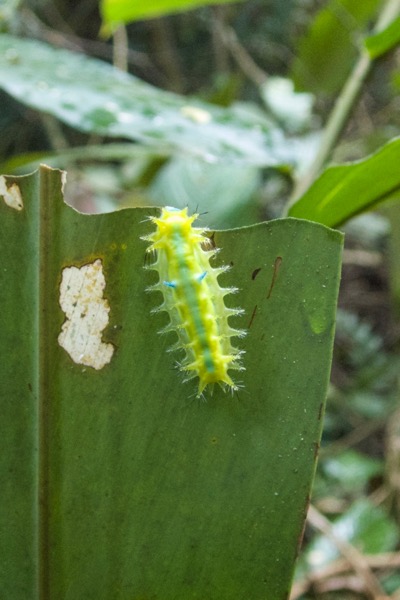
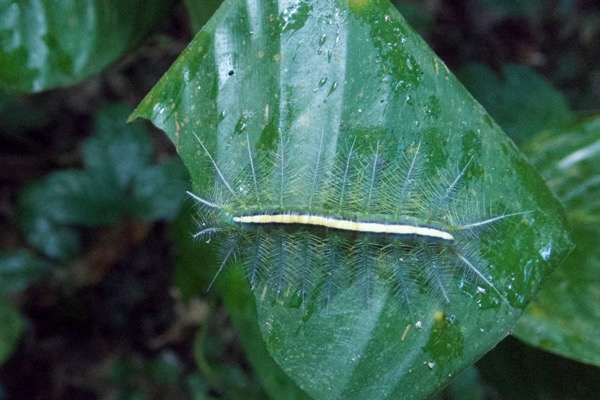
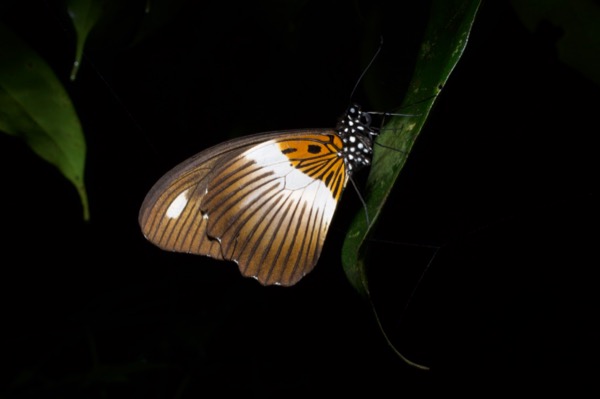
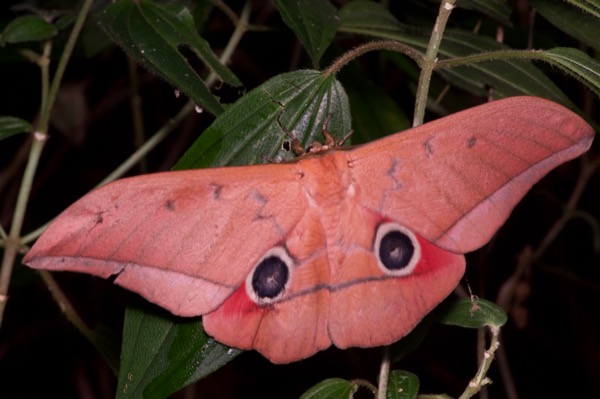

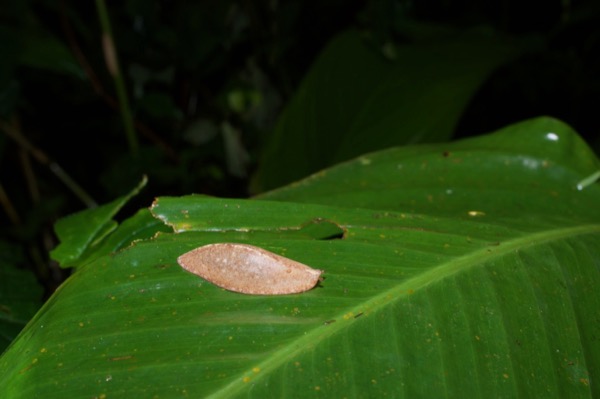
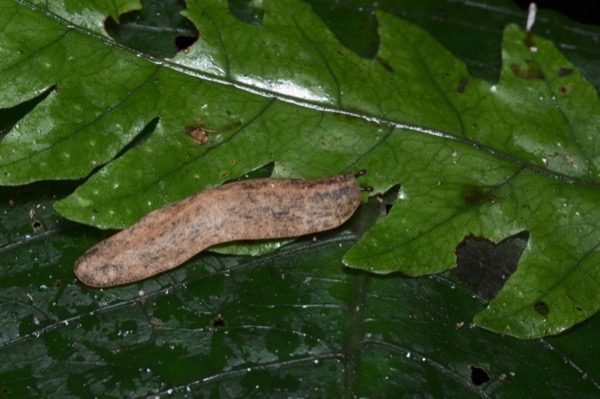
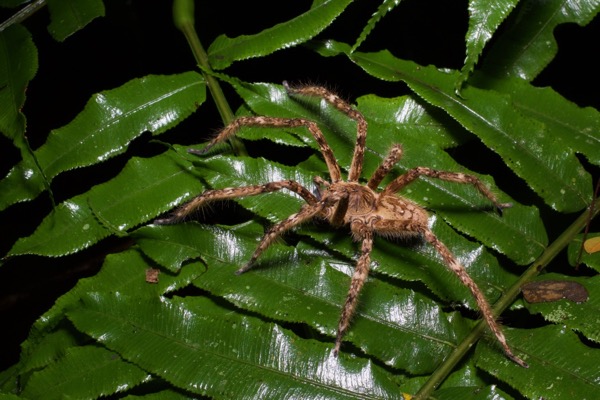
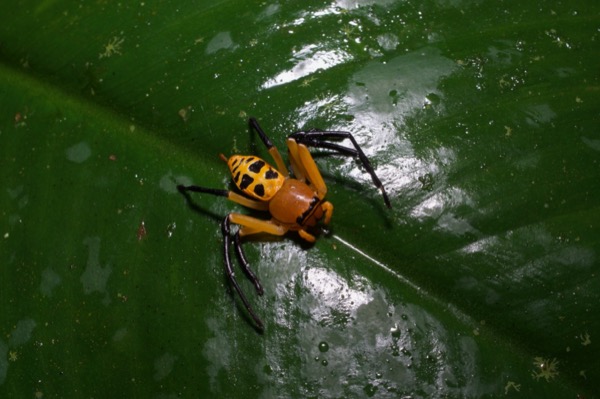
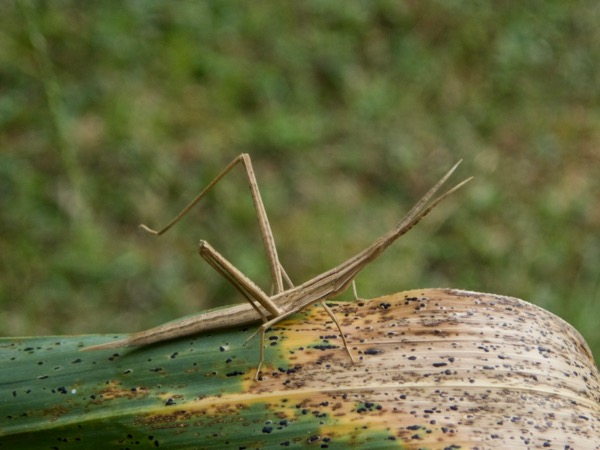
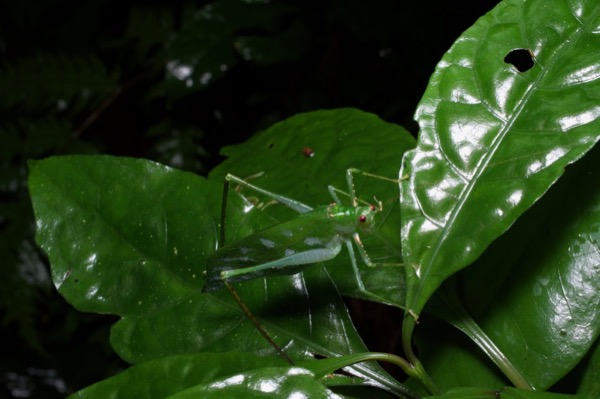


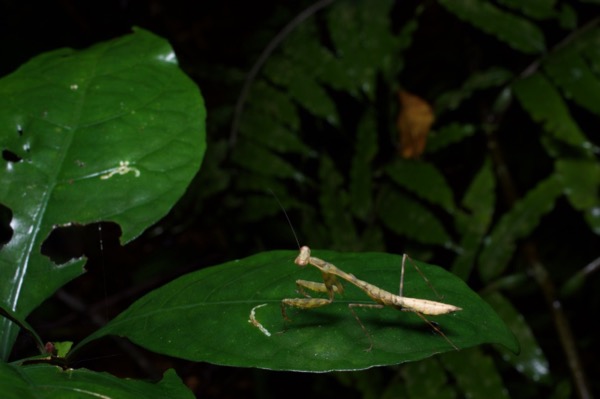
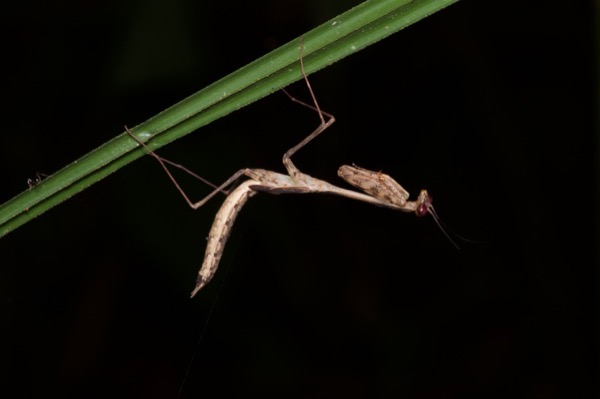
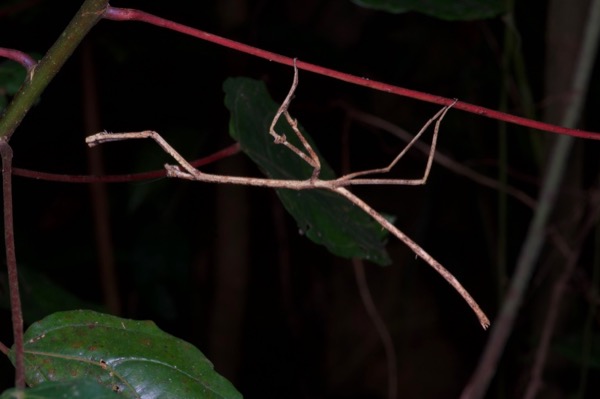
On to the herps! As in our first forest location, the most commonly seen herps were small brown Arthroleptis frogs. These were typically perched in low vegetation, one to three feet off the ground. As I mentioned earlier, these can't be IDed to the species level.
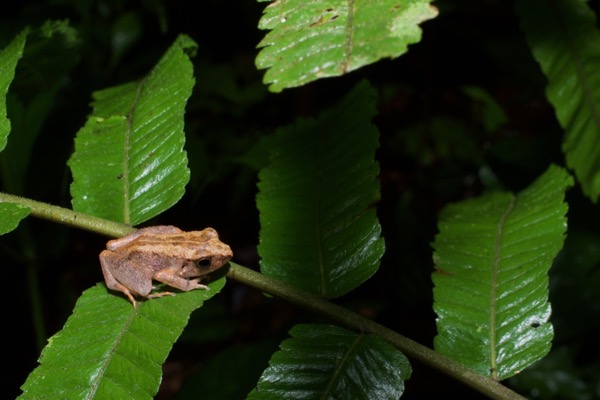

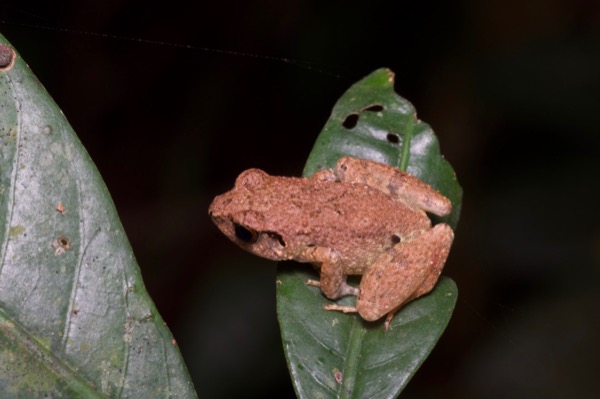
Smaller even than the little brown frogs, this little greenish frog had a beautiful mottled pattern.
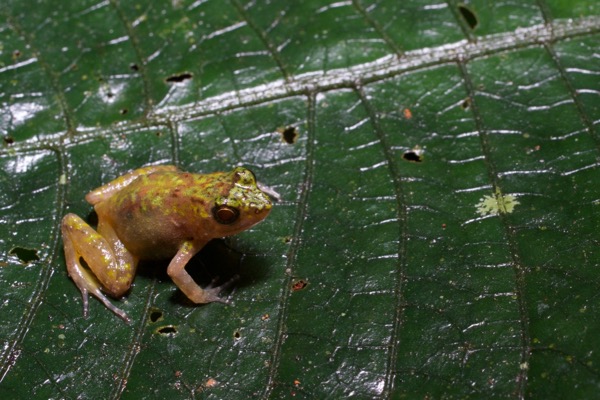
The smallest frog I saw in this forest seems to be a tiny neonate of the same greenish species. The cricket in the photo (which is admittedly closer to the camera, but only a little closer) is a very small cricket. The frog would have fit on my pinky fingernail.
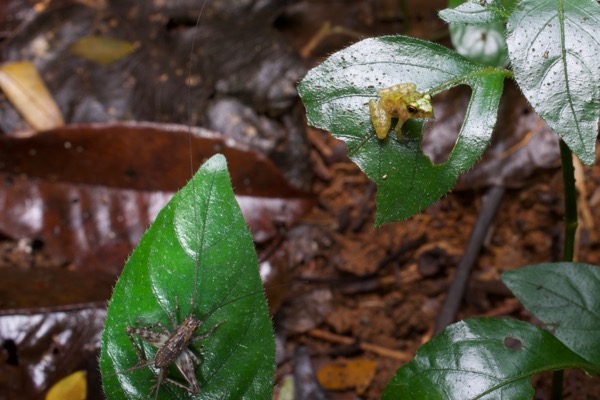
This location featured a stream and a large shallow permanent water body, the so-called "pond" I mentioned earlier. It was basically an area of medium-thick forest with a foot or two or three of water at the bottom. I found it pretty difficult to navigate through, but the frogs were very happy with it.
I saw only one ranid-type frog in this forest, this Forest White-lipped Frog. It was perched in the vegetation in the middle of the pond.
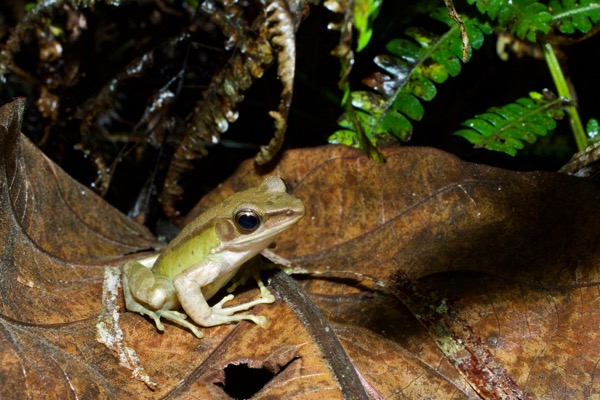
All of the other frogs I saw in the pond vegetation were your standard arboreal-type frogs. Let's call them treefrogs, without assuming that this means only the family Hylidae.
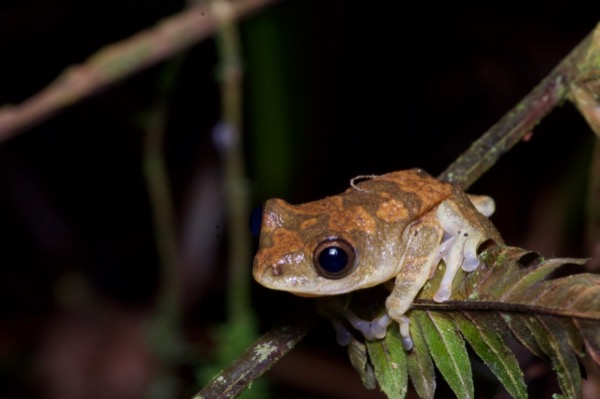
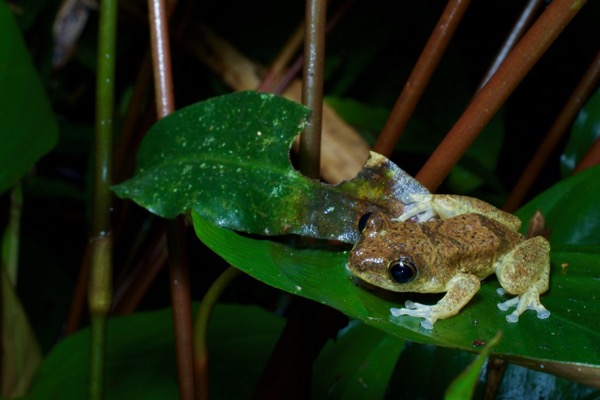

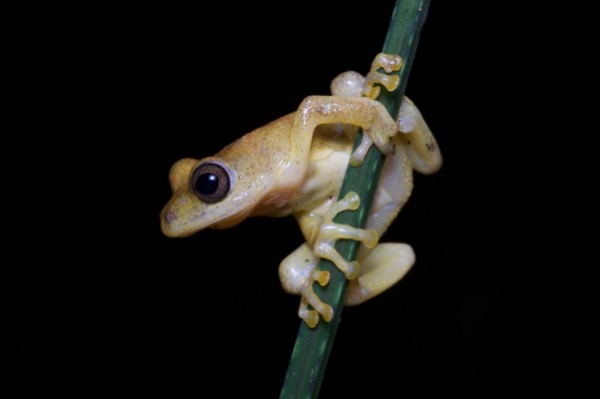
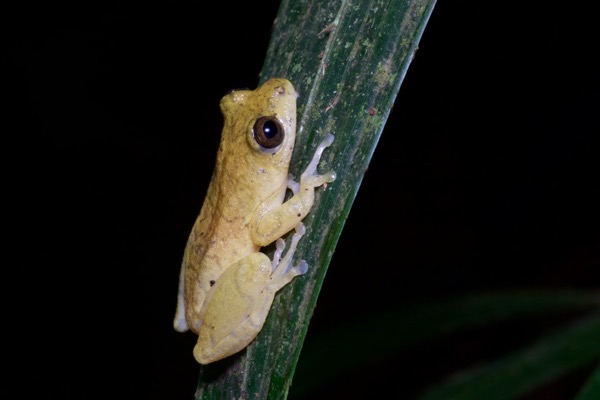

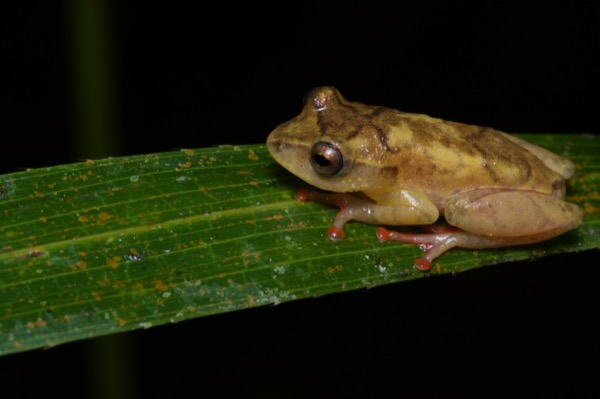

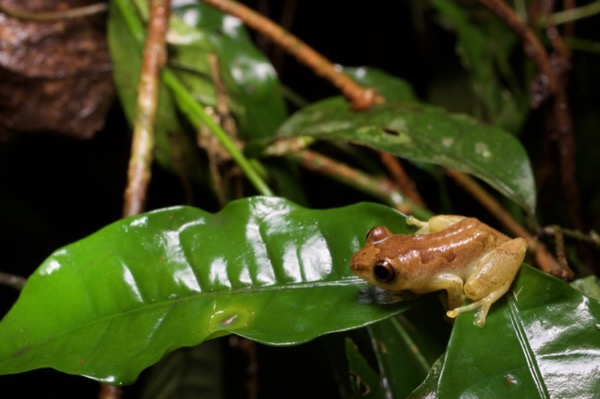
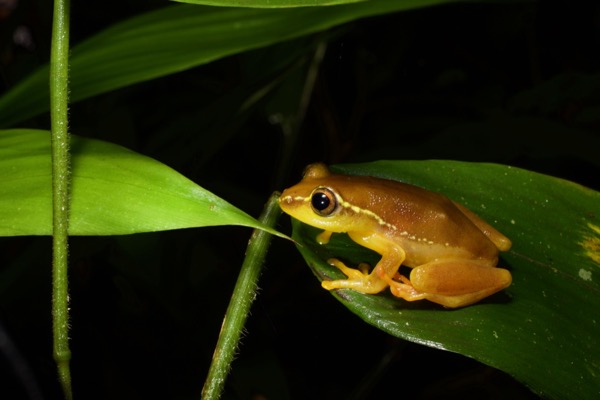
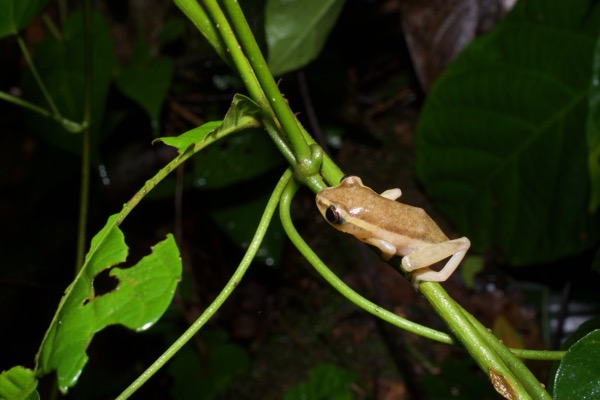
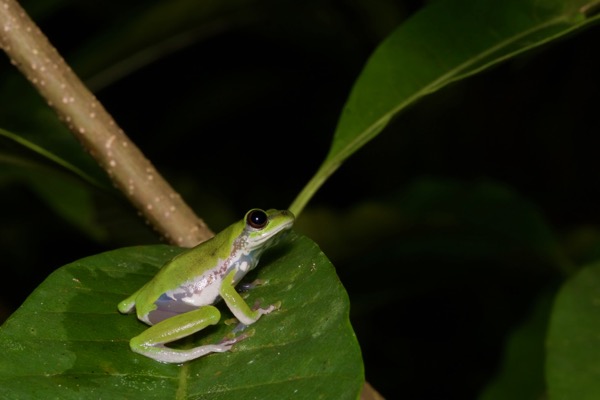
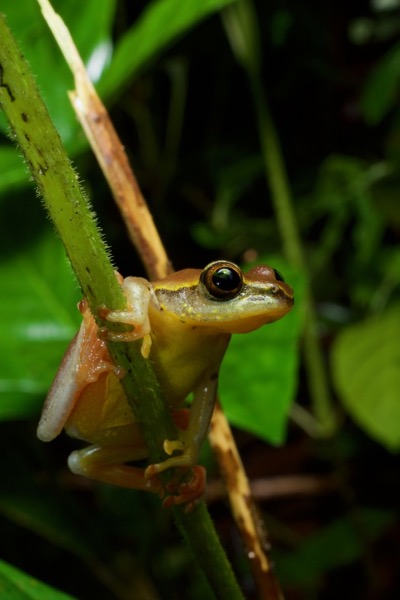
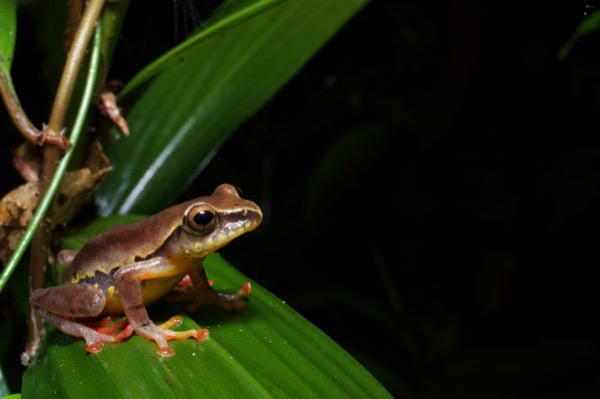

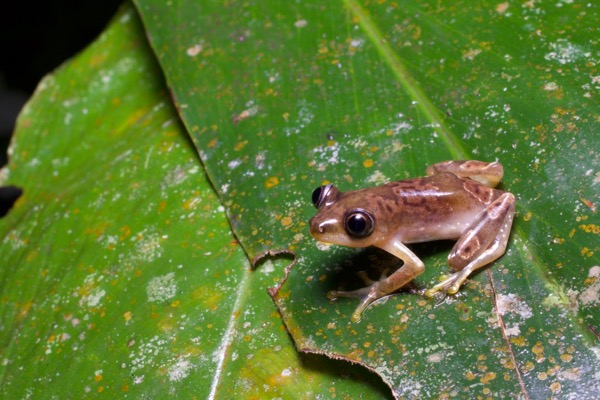
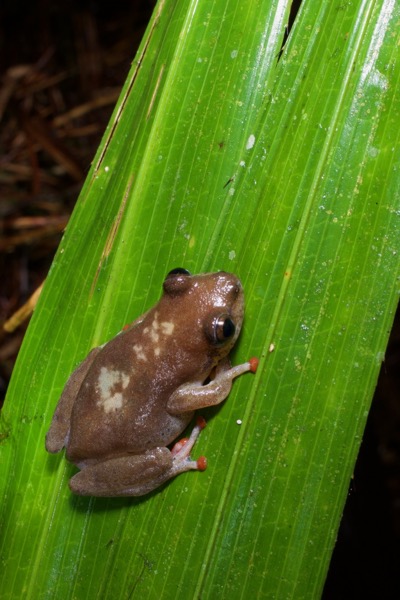
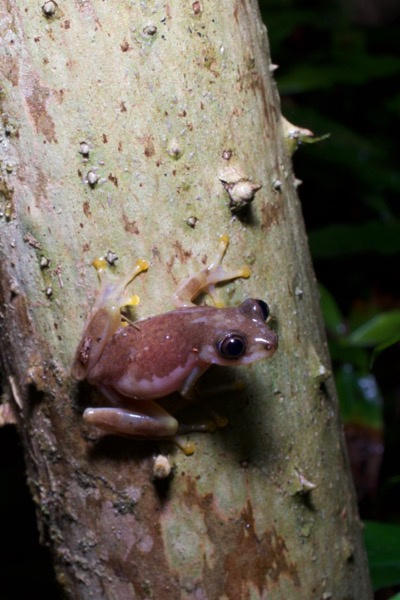
The second-best frogs we saw in Ghana were Ivory Coast Running Frogs. These fat, beautifully-marked glops of frog were typically perched in low vegetation, less than a foot off the ground, head facing down. I think they were looking for passing bugs to ambush from above. Their legs are too spindly to propel their fat little bodies in a significant jumping motion, so they typically walk, or walk quickly, hence "running frogs".
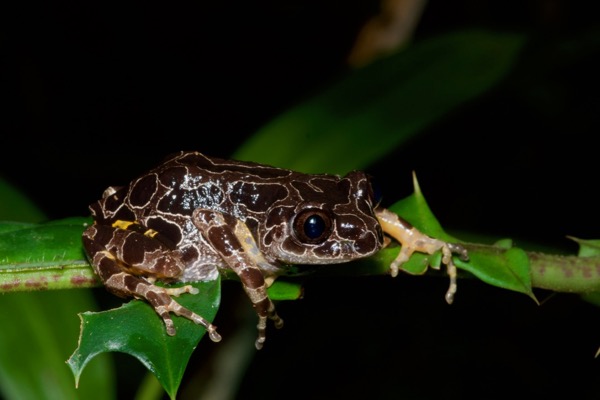
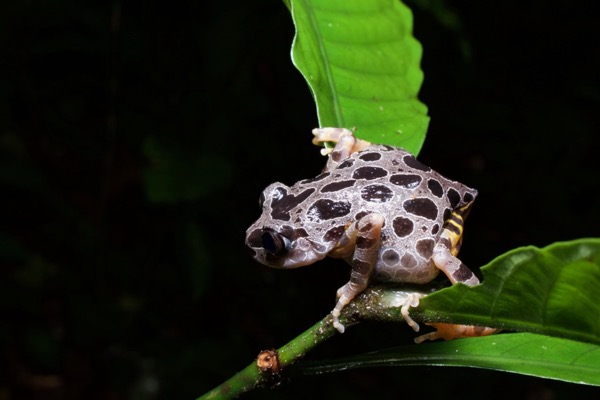
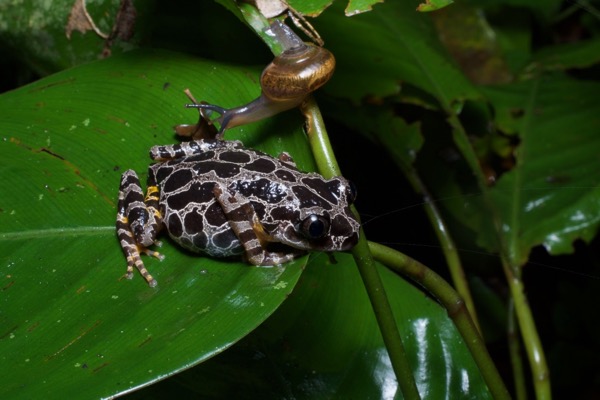
The best frogs we saw in Ghana were the critically endangered Togo Slippery Frogs. This species was thought to be extinct for a couple of decades until it was rediscovered in 2005. Eventually populations were found in a handful of locations in Togo and this one location in Ghana. And now, recent studies have revealed that the DNA of the Ghana population is sufficiently distinct to warrant separate species status, so the ones we saw were not Togo Slippery Frogs at all but a soon-to-be-named sister species known only from this one location. Now that's a rare frog! (Update: In 2021 the Ghana population was described as the new species Conraua sagyimase, a.k.a. the Atewa Slippery Frog.)
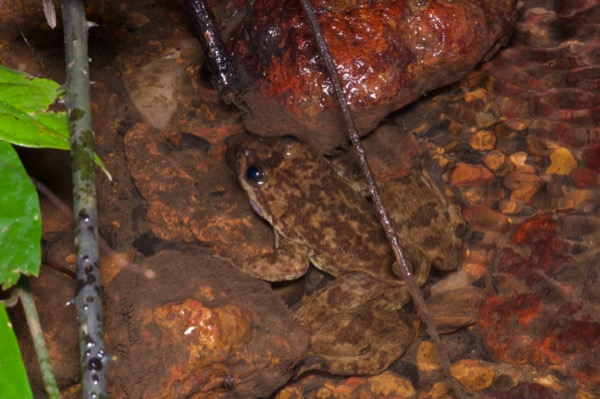
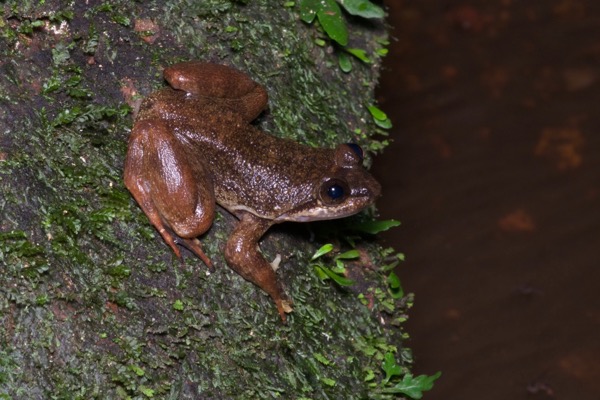
Lizards were even more difficult to find in this second forest. I saw only a couple of geckos, one of which was willing to pose nicely on a leaf. Too bad I don't even know what species it was,
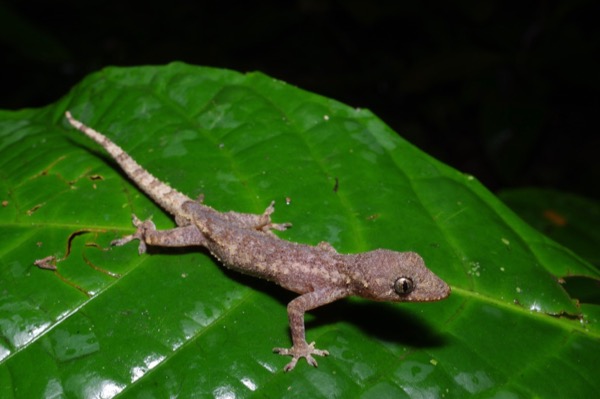
So much for lizards, but at least there was another species of four-legged reptile to entertain us. We saw four or five of these little guys in the shallow parts of the pond each night.

On our first night in this forest, we found a grand total of one snake. Here's what it looked like when we found it.

We managed to wake up and capture this little fellow without it escaping into the vegetation, but we didn't recognize what species it was. So we brought it back to camp so we could do a proper scale count and compare with our list of Ghana snakes the next day. This led us to the conclusion that it was a juvenile Thirteen-scaled Green Snake (with a name like that, you can see why counting the scales was important).

The next night we found two more of the same species, both before 10:00 or so. We left them in the forest, so my only pictures are fairly distant in situ shots like this:
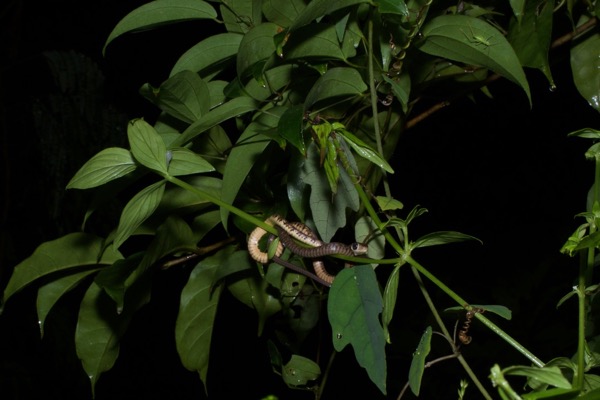
Everyone other than Kurt and me hit the sack by about 11:00. Kurt was not willing to sleep on his final night in a Ghana forest without seeing some more interesting type of snake. I tagged along, and an hour and a half later Kurt spotted what he had been looking for.
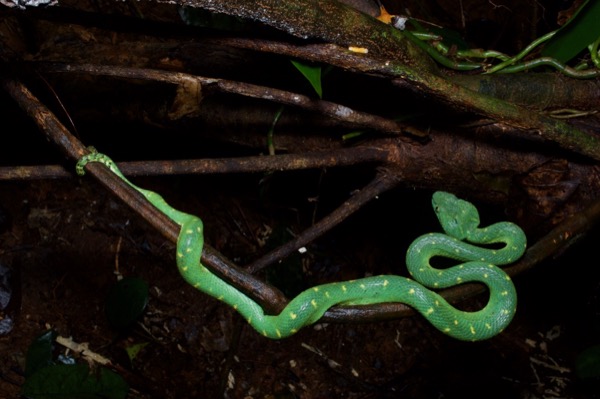
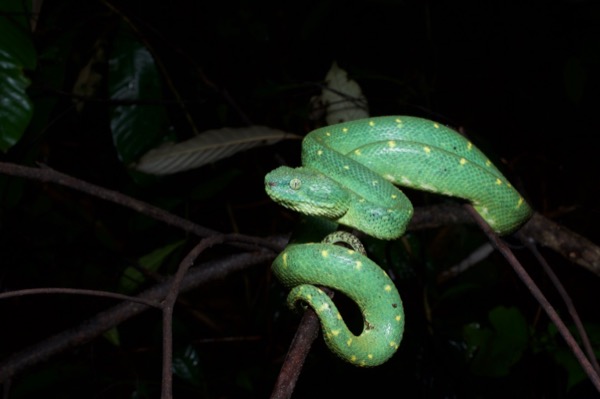
So once again, not many snakes to be found in the forest, but at least we saw one really good one. The next day, we hiked back out of the forest, passing a few skinks and agamas along the way (but only the same kinds we had already seen). Then we drove back to Accra and somehow ended up eating random fast food at a big mall.
The next morning we drove out to some savanna habitat in hopes of seeing a different assemblage of herpetofauna. We met up with Baturi's nephew Issah, who came pre-equipped with a recently caught chameleon (Chamaeleo senegalensis) and spitting cobra (Naja nigricollis). The chameleon was very dark after being kept in a cloth bag for I don't know how long, so it was placed in a small, solitary tree to allow it to warm/cheer up. Meanwhile, everyone except me gathered round the cobra, which had been released from a bag of its own and was not in a good mood.
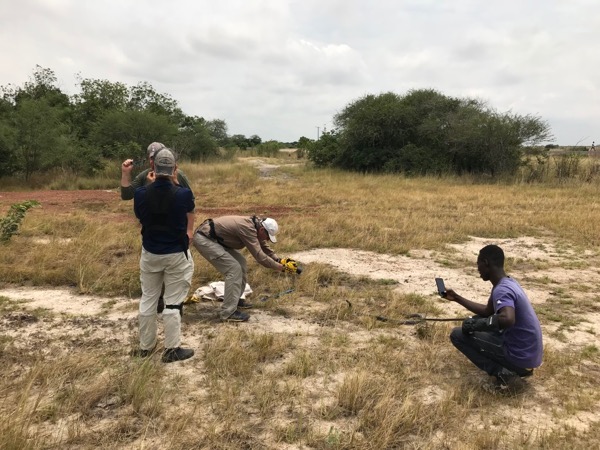
I'm generally only interested in photographing herps that I have seen while they were wild, so I didn't want pictures of the cobra or the chameleon and I wandered off to a nearby pond to see what I could stir up. I stirred up a large number of very small, jumpy frogs.
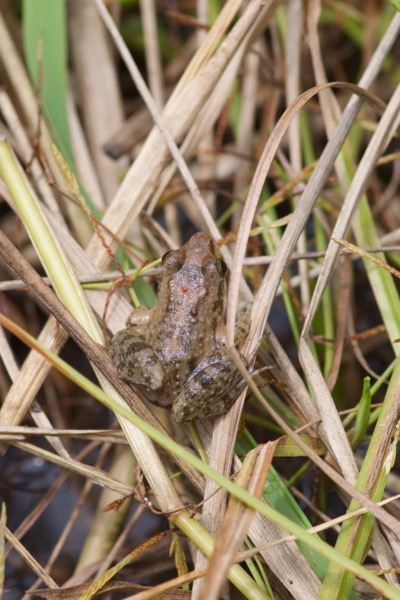

Meanwhile the rest of the gang were done messing about with the cobra, only to discover that no one could find the chameleon. The tree in which it had been placed was small and nearly devoid of leaves, and there were no other trees within twenty yards at least. Still, the chameleon was never seen again. I didn't think chameleons could fly, but now I am not sure.
We spent the rest of the morning wandering about the savanna looking for more herps. I did glimpse one more fairly large snake, but I saw it only as it was disappearing into some thick grasses, and Kurt and I could not rediscover it.
In addition to the many Accra River Frogs, I saw exactly one other frog. Just when I had a decent side-view photo lined up it turned its body, then hopped away, disappearing into a patch of vegetation. I managed to get one photo after it turned but before it hopped. Not a good photo, but enough to identify it.

Occasionally we saw a small agama dash from vegetation patch to vegetation patch. One of them dove into a small burrow, and Issah dug it out, but it escaped again before we could get any photos. A little while later I spotted one of them in the mottled light beneath a bush, and armed with my 300mm lens and tripod managed to get a photo.
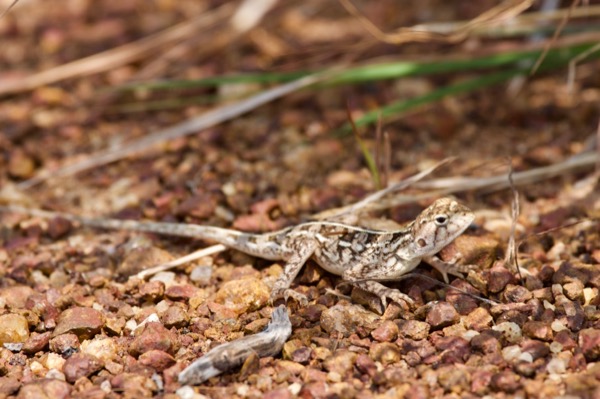
Unlike Monty and Paul, Kurt and I had late flights on our final day in Ghana, so we had time to head back out to the savanna with Issah for one final shot at finding herps. We carefully inspected areas where green mambas were reportedly seen reasonably often, but no green mambas were seen by us. In fact, we saw no herps at all that morning. We had to settle for a few good invertebrates.
This grass-mimic mantid hopped around like a flightless grasshopper. It was identified to the genus level by two different African mantis experts. Unfortunately they chose different genera.
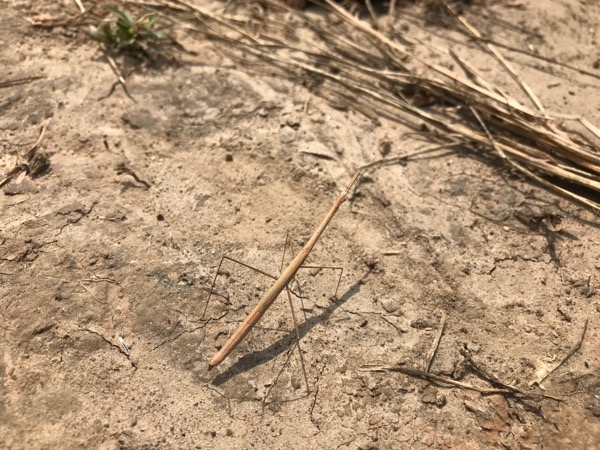
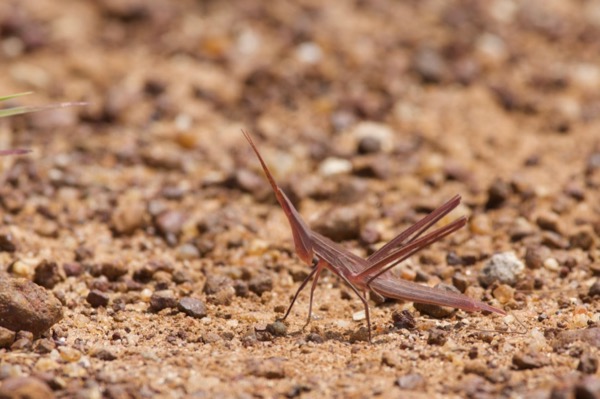
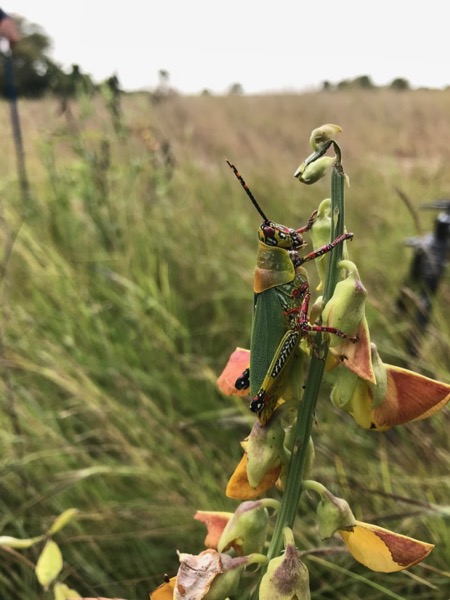
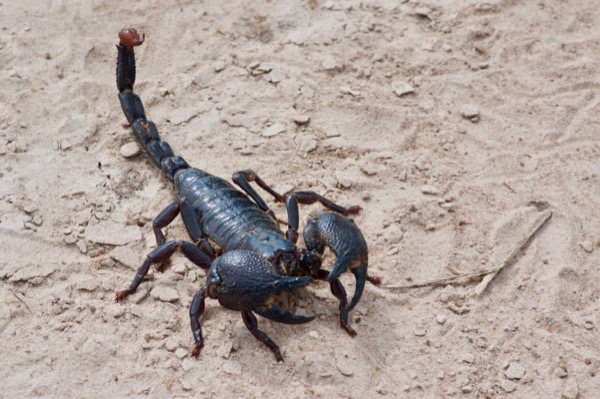
So in this short trip we didn't see as many snakes and lizards as we might have hoped, but we saw many excellent animals overall. Also, the company was good, the local people were friendly, and the food was good (though do note that I did *not* try the rat; Monty did, and unsurprisingly he regretted it). Also, nobody was attacked by wasps, or nearly died in any other way! I would happily go back, though I'd probably try a different time of year.
John Sullivan
March 2019